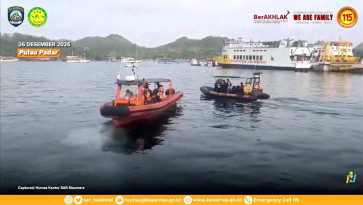Popular Reads
Top Results
Can't find what you're looking for?
View all search resultsPopular Reads
Top Results
Can't find what you're looking for?
View all search resultsScientists call for blue carbon mainstreaming
Scientists have urged stakeholders — from the government to local communities — to take part in efforts to put blue carbon on the national agenda to mitigate climate change and improve people’s livelihoods
Change text size
Gift Premium Articles
to Anyone
S
cientists have urged stakeholders — from the government to local communities — to take part in efforts to put blue carbon on the national agenda to mitigate climate change and improve people’s livelihoods.
The call was made during the two-day Blue Carbon Summit, an international scientific conference organized by the Indonesian Academy of Sciences (AIPI) in partnership with the Center for International Forestry Research (CIFOR), which ended on Wednesday.
Blue carbon ecosystems, which include mangroves and seagrasses, have been deemed an important component in climate change mitigation because of their significant carbon storage capacities and ability to “help coastal regions keep pace with the rising sea level”, CIFOR scientist Daniel Murdiyarso said on Wednesday.
“Blue carbon ecosystems also provide numerous services to people, and now is the time to consider their role in developing alternative livelihoods. Sustainable ecotourism, fisheries and shellfish farming are all industries that generate direct economic benefits while protecting intact mangroves,” Daniel added.
Such importance has encouraged researchers to urge the government to mainstream the blue carbon issue in the national policies and development agenda.
However, the mainstreaming process has been hindered by several issues, including a lack of coordination between government agencies.
Mangrove forests and seagrass meadows are among the commonly known blue carbon ecosystems. However, they are managed under different government agencies in Indonesia. Mangroves are mostly handled by the Environment and Forestry Ministry, while seagrasses are dealt with by the Maritime Affairs and Fisheries Ministry.
The problem can be addressed by the government’s National Mangrove Working Group (KKMN) and its partners at the regency and municipal levels. The establishment of the working group was mandated by Presidential Regulation No. 73/2012 on national mangrove ecosystem management strategy.
“While those at regional level are still quite active, the national working group has been idle for a while, probably because of the lack of funding. Maybe it’s time for the working group to be reactivated,” said Nyoman Suryadiputra, KKMN secretary and the Indonesian director of nongovernmental organization Wetlands.
While funding has also been seen as a hindrance to blue carbon mainstreaming, the Public-Private Partnerships (PPP) scheme, through which the private sector contributes to funding needed to conserve or rehabilitate ecosystems, is considered one of the solutions.
“Mechanisms to finance the blue carbon economy must reflect the unique benefits and challenges of blue carbon and help overcome institutional biases,” Daniel said.
While the development of blue carbon potentials is not yet a government policy focus, Coordinating Maritime Affairs Minister Luhut Binsar Pandjaitan claimed that the government had at least completed the necessary measures to support the idea.
“We have started to replant mangroves and seagrasses in several coastal areas. We are also trying to tackle marine debris, which threatens blue carbon ecosystems,” Luhut said, adding that the government had allocated US$1 billion to develop blue carbon potentials for five years since 2017.
Moreover, the Office of the Coordinating Maritime Affairs Minister has also started its attempts to conserve and rehabilitate mangrove forests by monitoring the latest condition of the forests and other ocean ecosystems using satellites. The initial attempt was done in partnership with the National Institute of Aeronautics and Space (Lapan) and the Geospatial Information Agency (BIG).
“This is our attempt to get the latest data on wetlands, especially mangroves, as we have been using obsolete data until now,” said Safri Burhanuddin, an official with the Office of the Coordinating Maritime Affairs Minister.
The office, he added, had allocated funds amounting to $200,000 to cover the costs of the measures. The money was part of a financial grant from Denmark and Norway for ocean conservation.










